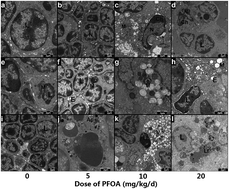The mechanism of immunosuppression by perfluorooctanoic acid in BALB/c mice
Abstract
Perfluorooctanoic acid (PFOA) has been demonstrated to decrease immunity of mice, but little is known about the mechanisms of its immunotoxicity. In order to determine whether the immunotoxicity of PFOA is associated with lipid metabolism, male BALB/c mice were fed with either a regular (RD) or high fat (HFD) diet, and exposed to PFOA at doses of 0, 5, 10, and 20 mg kg−1 per day for 14 days. Following exposure, the body weights of RD-fed mice treated with PFOA were significantly decreased, and the immune system organs showed serious atrophy. Histopathological and ultrastructural changes were also detected. At the same time, the gene expressions of peroxisome proliferator-activated receptor (PPAR) α and γ were also up-regulated in the thymus and the spleen. The percentage of apoptotic cells increased with increasing doses of PFOA, and a larger number of lymphocytes underwent apoptosis within the thymus than the spleen. In the HFD exposure groups, similar phenomena were still observed. HFD feeding caused up-regulation of PPARγ but not PPARα within the thymus of PFOA groups. These results suggest that an excess of dietary lipids does not prevent PFOA-induced immune suppression caused by peroxisome proliferators, and immunomodulation by PFOA is via the PPAR pathway, and the induction of mitochondrial damage and lymphocyte apoptosis pathway.


 Please wait while we load your content...
Please wait while we load your content...